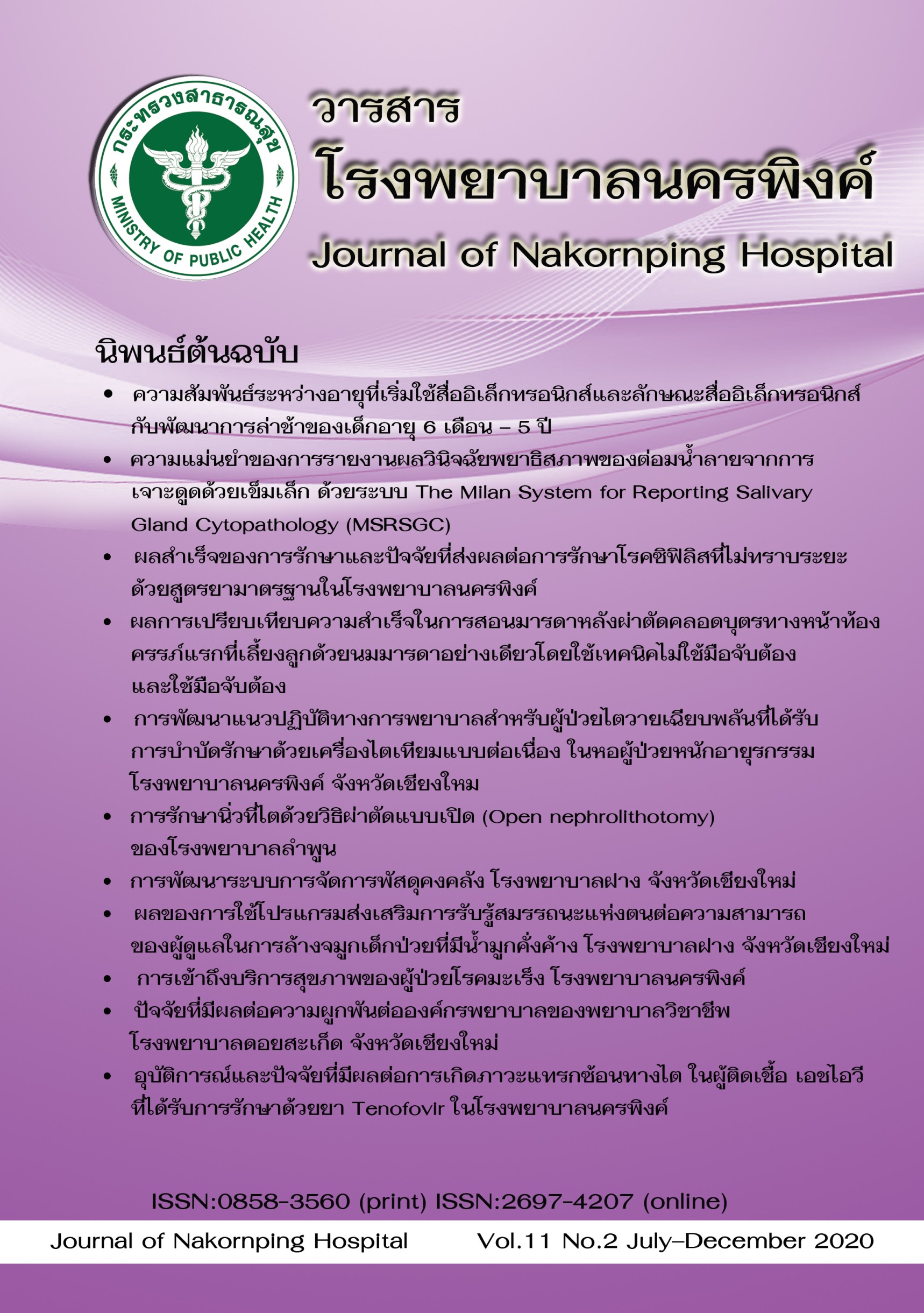A comparison of success rate of primiparous caesarian mother between using one hand and hand off Breastfeeding technique
Keywords:
Primiparous Cesarian mother, hand off technique, exclusive breastfeedingAbstract
Objective: To assess the success of exclusive breastfeeding teaching technique between using hand off and one hand technique in primiparous caesarian mothers
Study design: This is a quasi-experimental research and posttest control group design in primiparous caesarian mothers in Nakornping hospital during January-April 2020. Subjects were selective sampling and divided into 2 groups, a study group: a mother who had been taught to use hand off technique and a control group: a mother who had been taught to use one hand technique. Questionnaires were used to evaluate the outcomes. Data was analyzed using descriptive; number, percentage, mean, median, SD, iqr and analytic statistics; Chi-Square and Mann-Whitney U test.
Result: Mothers in the study group had low complication than the control group in terms of nipple pain (n=3, 7.7%, p=0.035) nipple cracking (n= 2, 11.5%, p=0.048) and breast engorgement (n= 6, 23.1%, p=0.044). They also had sufficient milk supply more than the control group, p= 0.008. They had intention to exclusive breastfeed than the control group, 25 mothers (96.2% vs. 19(73.1%), p=0.021). In addition, their intended duration to exclusive breastfeeding was 27.36 weeks (SD 5.50) in the study group compared to 21.79 weeks (SD 6.70) in the control group, p= 0.022.
Conclusions: The hand off technique breastfeeding had increased desire to 6 months exclusive breastfeeding and it is easy and feasible to imply to support breastfeeding program.
References
Anatolitou F. Human milk benefits and breastfeeding. JPNIM. 2012;1(1):11-18.
World Health Organization. Ten steps to successful breastfeeding [Internet]. Switzerland: World Health Organization; 2018. Available from: https://www.who.int/activities/promoting-baby-friendly-hospitals/ten-steps-to-successful-breastfeeding.
กระทรวงสาธารณสุข, กรมอนามัย, สำนักอนามัยการเจริญพันธ์. นโยบายและยุทธศาสตร์การพัฒนาอนามัยการเจริญพันธุ์แห่งชาติฉบับที่ 2 (พ.ศ. 2560-2569) ว่าด้วยการส่งเสริมการเกิดและการเจริญเติบโตอย่างมีคุณภาพ [อินเตอร์เน็ต]. นนทบุรี: กระทรวงสาธารณสุข; 2559 [เข้าถึงเมื่อ 15 ธันวาคม 2562]. เข้าถึงได้จาก: http://plan.psru.ac.th/index.php?module=policy&id=225
สำนักนายกรัฐมนตรี, สำนักงานคณะกรรมการพัฒนาการเศรษฐกิจและสังคมแห่งชาติ. แผนพัฒนาเศรษฐกิจและสังคมแห่งชาติของประเทศไทย ฉบับที่ 12 (พ.ศ. 2560-2564) [อินเตอร์เน็ต]. กรุงเทพฯ: สำนักนายกรัฐมนตรี; 2559 [เข้าถึงเมื่อ 15 ธันวาคม 2562]. เข้าถึงได้จาก: https://www.nesdc.go.th/ewt_dl_link.php?nid=6422
สำนักงานสถิติแห่งชาติ. ประเทศไทย การสำรวจสถานการณ์เด็กและสตรีในประเทศไทย พ.ศ. 2558-2559 [อินเตอร์เน็ต]. กรุงเทพฯ: สำนักงานสถิติแห่งชาติ; 2560 [เข้าถึงเมื่อ 15 ธันวาคม 2562]. เข้าถึงได้จาก: https://www.unicef.org/thailand/media/176/file/Key%20Findings%20from%20Thailand%20Multiple%20Indicator%20Cluster%20Survey%202015-2016%20(English).pdf
นิพรรณพร วรมงคล, อิสรีย์ เจตน์ประยุกต์, สมพงษ์ สกุลอิสริยาภรณ์. สถานการณ์การเลี้ยงลูกด้วยนมแม่ประเทศไทย ปี 2552-2553. วารสารวิชาการสาธารณสุข. 2554;20(5):721-31.
Karlström A, Engström-Olofsson R, Norbergh KG, Sjöling M, Hildingsson I. Postoperative pain after cesarean birth affects breastfeeding and infant care. J Obstet Gynecol Neonatal Nurs. 2007;36(5):430-40.
รุ่งฤดี จีระทรัพย์, นวลจันทร์ ไพบูลย์บรรพต, สมพร พานิคม. วิธีการคลอดและการมาของน้ำนมเต็มเต้าในมารดาหลังคลอด. วารสารวิชาการสาธารณสุข. 2553;19(2):270-78.
Rowe-Murray HJ, Fisher JR. Baby friendly hospital practices: Cesarean section is a persistent barrier to early initiation of breastfeeding. Birth. 2002;29(2):124-31.
ACOG Practice bulletin. Vaginal birth after previous cesarean delivery. Obstetrics and gynecology. 2010;116(2):450-63.
Wagner M. Choosing caesarean section. The Lancet. 2000;356(9242):1677-80.
World Health Organization. WHO statement on caesarean section rates [Internet]. Switzerland: World Health Organization; 2015. Available from: https://apps.who.int/iris/bitstream/handle/10665/161442/WHO_RHR_15.02_eng.pdf;jsessionid=1AD1F9A2CF9133085F1F142530F2C813?sequence=1
พรณิศา แสนบุญส่ง, วรรณดา มลิวรรณ์. การเลี้ยงลูกด้วยนมแม่อย่างมีคุณภาพ:ปัจจัยที่มีอิทธิพลต่อการเลี้ยงลูกด้วยนมแม่ และบทบาทของพยาบาลผดุงครรภ์. วารสารวิชาการมหาวิทยาลัยปทุมธานี. 2559;8(2):235-47.
สุภาพร สิทธิกร. ปัจจัยที่มีผลต่อการเลี้ยงลูกด้วยนมแม่อย่างเดียวของสตรีในจังหวัดนครปฐม [วิทยานิพนธ์ปริญญาวิทยาศาสตร์มหาบัณทิต]. กรุงเทพฯ: มหาวิทยาลัยมหิดล; 2551.
Lawrence RA, Lawrence RM. Breastfeeding: A guide for the medical profession. 6th ed. Philadelphia: Elsevier Mosby; 2005.
Alden KR, Lowdermilk DL, Cashion MC, Perry SE. Maternity & women’s health care. 10th ed. St. Louis: Mosby; 2012.
Davidson MR, London ML, Ladewig PA. Olds’ Maternity- newborn nursing & women health care. 9th ed. New Jersey: Person education; 2012.
ศิริขวัญ พรหมจำปา. ผลของโปรแกรมส่งเสริมการรับรู้สมรรถนะแห่งตนต่อพฤติกรรมการเลี้ยงลูกด้วยนมแม่ของมารดาวัยรุ่น [วิทยานิพนธ์พยาบาลศาสตรมหาบัณฑิต]. กรุงเทพฯ: มหาวิทยาลัยธรรมศาสตร์; 2552.
Murray SS, Mckinney ES. Foundations of Maternal-Newborn and Women’s Health Nursing. 5th ed. Marryland Heights: Saunders; 2010.
Fraser DM, Cooper MA. Myles textbook for Midwives. 15th ed. Edinburgh: Churchill Livingstone; 2009.
Weimers L, Svensson K, Dumas L, Naver L, Wahlberg V. Hand on approach during breastfeeding support in a neonatal intensive care unit: A qualitative study of Swedish mother’s experiences. Int Breastfeed J. 2006;1:20.
Morland-Schultz K, Hill PD. Prevention of and therapies for nipple pain: a systematic review. J Obstet Gynecol Neonatal Nurs. 2005;34(4):428-37.
Meedya S, Fahy K, Kable A. Factors that positively influence breastfeeding duration to 6months: a literature review. Women and birth. 2010;23(4):135-45.
Napier D. Hands off technique has many benefits for breastfeeding mother. BMJ. 2001;322(7291):929-30.
Ingram J, Johnson D, Greenwood R. Breastfeeding in Bristol: Teaching good position and support from fathers and families. Midwifery. 2002;18(1):87-101.
Fletcher D, Harris H. The implementation of the HOT Program at the Royal Women’s Hospital. Breastfeeding Rev. 2000;8(1):19-23.
Burns N, Grove SK.The practice of nursing research conduct, critique, and utilization. 5th ed. St. Louis: Elsevier Saunders; 2005.
บุษกร จันทร์จรมานิตย์, กรรณิการ์ กันธะรักษา, พรรณพิไล ศรีอาภรณ์. ผลของการสอนโดยใช้เทคนิคไม่ใช้มือจับต้องต่อความสำเร็จในการเลี้ยงบุตรด้วยนมมารดาอย่างเดียวของมารดาที่มีบุตรคนแรก. พยาบาลสาร. 2558;42(3):24-36.
กรรณิการ์ วิจิตรสุคนธ์. การเลี้ยงลูกด้วยนมแม่: ปัญหา อุปสรรค การช่วยเหลือ ใน: ชาญชัย วันทนาสิริ,วิทยา ถิฐาพันธ์, ปราโมท ไพรสุวรรณ, สุนทร ฮ้อเผ่าพันธุ์, บรรณาธิการ. เวชศาสตร์ปริกำเนิด. กรุงเทพฯ: ชัยเจริญการพิมพ์; 2550.
โบว์ชมพู บุตรแสงดี, กรรณิการ์ กันธะรักษา, จันทรรัตน์ เจริญสันติ. ผลของการส่งเสริมสมรรถนะแห่งตนต่อความสำเร็จในการเลี้ยงบุตรด้วยนมมารดาอย่างเดียวของมารดาที่ผ่าตัดคลอดทางหน้าท้อง. พยาบาลสาร. 2556;40(3):1-10.
นงนุช เจริญสุระสถล, พรรณรัตน์ แสงเพิ่ม, สุภาพันธ์ เหมือนวัดไทร, พฤหัส จันทร์ประภาพ. ผลของการสอนการจัดท่าให้นมลูกโดยการสาธิตต่อประสิทธิภาพการให้นมแม่ ความมั่นใจของแม่ก่อนจำหน่ายกลับบ้าน และอัตราการเลี้ยงลูกด้วยนมแม่อย่างเดียวของมารดาหลังคลอด. Nursing Science Journal of Thailand. 2562;37(3):79-90.
วรัญญา ชลธารกัมปนาท, จันทิมา ขนบดี, ปรานี ป้องเรือ. ผลของโปรแกรมส่งเสริมการรับรู้สมรรถนะแห่งตนต่อพฤติกรรมการดูแลตนเองและทารกแรกเกิดของมารดาครรภ์แรก. วารสารวิทยาลัยพยาบาลพระปกเกล้า จันทบุรี. 2561;29(1):29-41.
ขนิษฐา ปานยิ้ม. ประสิทธิผลของการใช้แนวปฏิบัติที่เป็นเลิศสำหรับการส่งเสริมการเลี้ยงลูกด้วยนมแม่ โรงพยาบาลพบพระ จังหวัดตาก [วิทยานิพนธ์พยาบาลศาสตรมหาบัณฑิต]. เชียงใหม่: มหาวิทยาลัยเชียงใหม่; 2554.
พรพิมล อาภาสสกุล, อุษา วงศ์พินิจ. ผลของการใช้ชุดส่งเสริมการเลี้ยงลูกด้วยนมแม่ต่อความสามารถในการเลี้ยงลูกด้วยนมแม่ของสตรีหลังคลอด. วารสารพยาบาลทหารบก. 2562;20(2):102-111.
Downloads
Published
How to Cite
Issue
Section
License
The articles that had been published in the journal is copyright of Journal of Nakornping hospital, Chiang Mai.
Contents and comments in the articles in Journal of Nakornping hospital are at owner’s responsibilities that editor team may not totally agree with.



